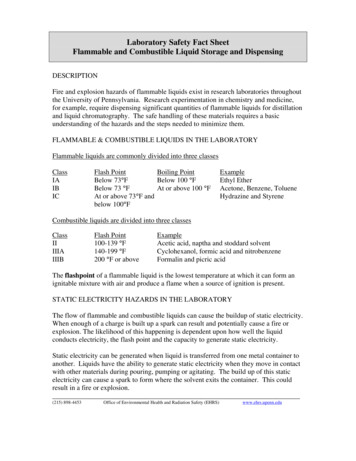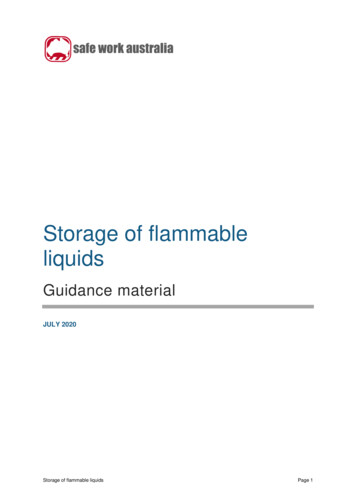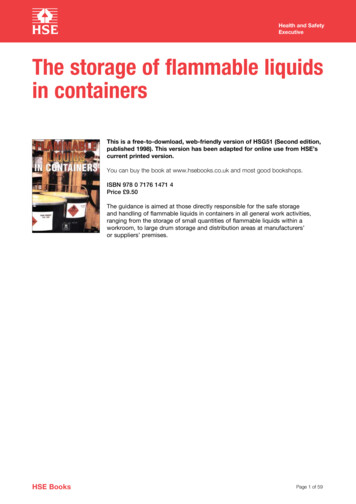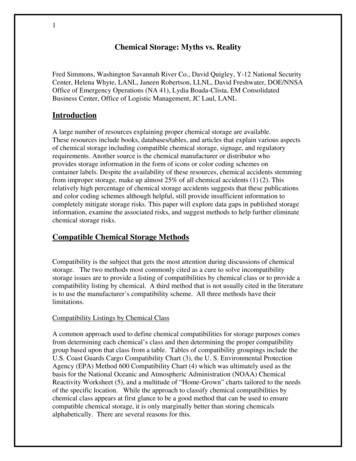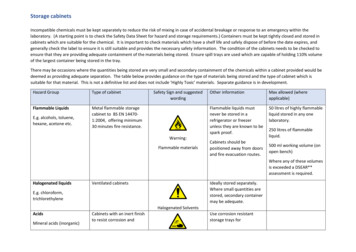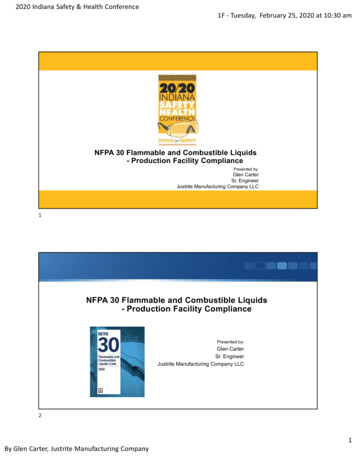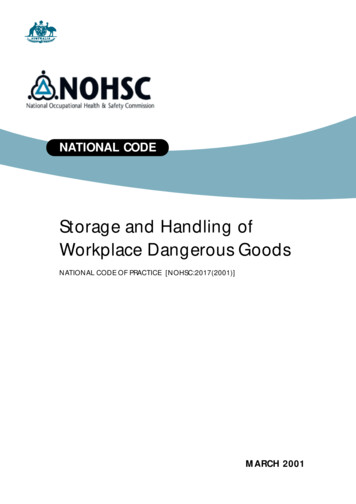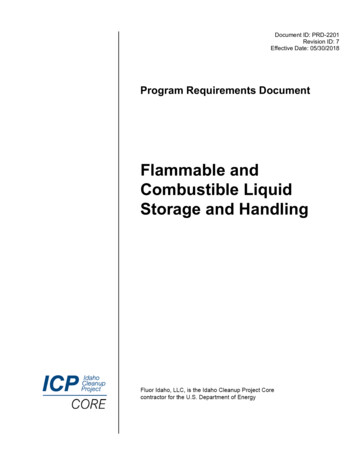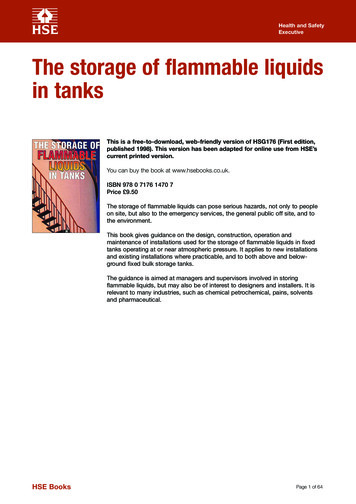
Transcription
Health and SafetyExecutiveThe storage of flammable liquidsin tanksThis is a free-to-download, web-friendly version of HSG176 (First edition,published 1998). This version has been adapted for online use from HSE’scurrent printed version.You can buy the book at www.hsebooks.co.uk.ISBN 978 0 7176 1470 7Price 9.50The storage of flammable liquids can pose serious hazards, not only to peopleon site, but also to the emergency services, the general public off site, and tothe environment.This book gives guidance on the design, construction, operation andmaintenance of installations used for the storage of flammable liquids in fixedtanks operating at or near atmospheric pressure. It applies to new installationsand existing installations where practicable, and to both above and belowground fixed bulk storage tanks.The guidance is aimed at managers and supervisors involved in storingflammable liquids, but may also be of interest to designers and installers. It isrelevant to many industries, such as chemical petrochemical, pains, solventsand pharmaceutical.HSE BooksPage 1 of 64
Health and SafetyExecutive Crown copyright 1998First published 1998ISBN 978 0 7176 1470 7All rights reserved. No part of this publication may be reproduced, stored ina retrieval system, or transmitted in any form or by any means (electronic,mechanical, photocopying, recording or otherwise) without the prior writtenpermission of the copyright owner.Applications for reproduction should be made in writing to:The Office of Public Sector Information, Information Policy Team,Kew, Richmond, Surrey TW9 4DU or e-mail: licensing@opsi.gov.ukThis guidance is issued by the Health and Safety Executive. Following the guidanceis not compulsory and you are free to take other action. But if you do follow theguidance you will normally be doing enough to comply with the law. Health andsafety inspectors seek to secure compliance with the law and may refer to thisguidance as illustrating good practice.Note: material previously contained in The storage of flammable liquids in fixedtanks (up to 10 000 m3 total capacity) HSG50 1990 and The storage of flammableliquids in fixed tanks (exceeding 10 000 m3 total capacity) HSG52 1991Page 2 of 64
Health and SafetyExecutiveContentsIntroduction 5General 5Scope of this document 5Fire and explosion hazards 7Legal requirements 8Risk assessment 9Control measures 9Location and layout of tanks 13General 13Tanks above ground 14Separation distances for ‘small’ tanks 15Separation distances for groups of ‘small’ tanks 16Separation distances for ‘large’ tanks 17Separation from other dangerous substances 17Storage of flammable liquids in buildings 18Underground tanks 19Design and construction 20The design of the tank 20Corrosion protection 21Installing the tank 24Pipework to and from the tank 24Tank connections and fittings 26Valves 27Pumps 27Contents measurement 28Vents 29Emergency relief venting 30Fire protection 30Bonding and earthing 31Bunding 32Marking tanks and fittings 33Lighting 34Weather protection 34Testing of tanks and pipework 34Heated tanks 35Loading and unloading facilities 36Loading and unloading of road tankers 36Transfer by rail 37Operation of road and rail facilities 37Inspection and maintenance39Permit-to-work systems 39Modifying the storage installation 40Decommissioning tanks 40Demolishing tanks 41Fire precautions 42Fire-fighting equipment and facilities 42The storage of flammable liquids in tankspage 3 of 65
Health and SafetyExecutiveEmergency procedures 44Security 45Training 46Higher-flashpoint liquids 47Sources of ignition 47Location of tanks above ground 47Storage in buildings 48Venting 48Marking and labelling 48Road and rail tankers 48Appendix 1 Legal requirements 49References 55Glossary 61Further information 64The storage of flammable liquids in tanksPage 4 of 65
Health and SafetyExecutiveIntroductionGeneral1 This book gives guidance on the design, construction, operation andmaintenance of installations used for the storage of flammable liquids in fixed tanksoperating at or near atmospheric pressure. It applies to new installations and toexisting installations where reasonably practicable. It replaces HSG50 The storageof flammable liquids in fixed tanks (up to 10 000 m3 total capacity) and HSG52 Thestorage of flammable liquids in fixed tanks (exceeding 10 000 m3 total capacity).2 The guidance is aimed at managers and supervisors involved in storingflammable liquids. It is relevant to many industries such rmaceutical.It may also be of interest to designers and installers. Trade organisations may wishto use the guidance as a basis for more specific guidance for their own members.3 This book gives help in the assessment of the risks arising from the storage offlammable liquids, and it describes measures to control those risks. Assessment,by employers and the self-employed, of the risks to workers and others who maybe affected by their activities is one of the requirements of the Management ofHealth and Safety at Work Regulations 19921,2,3. This publication also adviseson how to comply with the relevant parts of the Health and Safety at Work etcAct 19744,5,6 and the Highly Flammable Liquids and Liquefied Petroleum GasesRegulations 19727-13, and with other relevant legislation.4 Legal requirements, guidance and the standards referred to in this guidance arelisted in the reference section. They are subject to amendment from time to time.Where a British Standard is quoted, any other national or international standardwhich provides an equivalent level of safety is acceptable. The glossary at the backof this book explains the particular terms used in this guidance.Scope of this documentWhat this guidance applies to5 This guidance applies to flammable liquids with a flashpoint of 55 C or below.This includes all highly flammable liquids (as defined by the Highly FlammableLiquids and Liquefied Petroleum Gases Regulations 19727) and all petroleum spiritand petroleum mixtures as defined in the Petroleum (Consolidation Act) 192814 andthe Petroleum (Mixtures) Order 192915. It includes all liquids that are classified asflammable, highly flammable or extremely flammable for supply according to CHIP:Chemicals (Hazard Information and Packaging for Supply) Regulations 199616-20.6 The guidance is also relevant to liquids with a flashpoint above 55 C which arestored at temperatures above their flashpoint.7 Some of the precautions described may not be necessary for liquids with aflashpoint in the range 32 –55 C and stored at ambient temperature. Advice onless restrictive measures for these liquids is given in paragraphs 223–235. WhereThe storage of flammable liquids in tanksPage 5 of 64
Health and SafetyExecutiveno variation is given, the advice in the main text applies.8 The guidance applies to above and below ground fixed bulk storage tanks. Itapplies to premises where flammable liquids are stored in individual tanks or groupsof tanks. It may also be applied to portable or skid mounted vessels with capacitiesin excess of 1000 litres.9Advice is provided on transfer facilities for road and rail loading and unloading.What the guidance does not apply to10 The guidance does not apply to:nnnnnnnnnflammable liquids stored in portable containers and drums with capacities of1000 litres or less. These are covered by HSG51 The storage of flammableliquids in containers8. Generally, the storage of flammable liquids in fixedbulk tanks is preferable to storage of the same quantity in drums or similarcontainers, as spillage during handling is reduced;liquids with a flashpoint between 21 C and 55 C but which do not supportcombustion when tested at 55 C, in the manner described in Schedule 2 ofthe Highly Flammable Liquids and Liquefied Petroleum Gases Regulations19727;flammable liquids which present special hazards requiring specific storageconditions, such as ethylene oxide, peroxides, and other liquids which entail arisk of rapid decomposition, polymerisation or spontaneous combustion;petroleum kept in fixed tanks at retail filling stations. Guidance on fillingstations and similar private premises is available in HSG146 Dispensing petrol:Assessing and controlling the risk of fire and explosion at sites where petrol isstored and dispensed as a fuel21;carriage of flammable liquids (on or off site), including temporary storage at lorryparks and transit areas;liquefied petroleum gas and other substances which are gases at ambienttemperature and pressure but are stored as liquids under pressure orrefrigeration;flammable liquids stored under pressure. In these cases the guidance on LPGstorage22 may be appropriate;vessels, which are an integral part of process plant;loading and unloading of ships. This is covered by Guidance Note GS40 Theloading and unloading of flammable liquids and gases at harbours and inlandwaterways23,24.11 Released vapours arising from the storage of flammable liquids can haveenvironmental consequences and may be subject to controls under theEnvironmental Protection Act 199025,26,27. Although this guidance does not attemptto cover environmental issues, the advice it contains for the safe storage offlammable liquids will also provide protection for the environment. Further guidanceis available from the Environment Agency, the Scottish Environmental ProtectionAgency or from local authorities, who enforce the Environmental Protection Act.12 Flammable liquids can also pose a health hazard if they are inhaled, ingestedor come into contact with skin or eyes. Information on the health hazards of aparticular liquid, and on any specific precautions required, should be obtained fromthe safety data sheet17 or from the supplier. The Control of Substances Hazardousto Health Regulations 198828,29 require employers to assess the risks from exposureto hazardous substances and the precautions needed.The storage of flammable liquids in tanksPage 6 of 64
Health and SafetyExecutiveFire and explosion hazards13 The main hazards associated with the storage and handling of flammableliquids are fire and explosion, involving either the liquid or the vapour given offfrom it. Fires and explosions are likely to occur when vapour or liquid is releasedaccidentally or deliberately into areas where there may be an ignition source, orwhen an ignition source is introduced into an area where there may be flammableatmospheres.14 Common causes of such incidents include:nnnnnnnnnnninadequate design and installation of equipment;inadequate inspection and maintenance;failure or malfunction of equipment;lack of awareness of the properties of flammable liquids;operator error, due to lack of training;exposure to heat from a nearby fire;inadequate control of ignition sources;electrostatic discharges;heating materials above their auto-ignition temperature;dismantling or disposing of equipment containing flammable liquids;hot work on or close to flammable liquid vessels.15 Combustion of liquids occurs when flammable vapours released from thesurface of the liquid ignite. The amount of flammable vapour given off from a liquid,and therefore the extent of the fire or explosion hazard, depends largely on thetemperature of the liquid, how much of the surface area is exposed, how long it isexposed for, and the air movement over the surface. The hazard also depends onthe physical properties of the liquid such as flashpoint, auto-ignition temperature,viscosity, and the upper and lower explosion limits.16 The flashpoint is the lowest temperature at which a flammable liquid gives offvapour in sufficient quantity to form a combustible mixture with air near the surfaceof the liquid. Generally, a liquid with a flashpoint below the ambient temperaturewill give off sufficient flammable vapour which when mixed with air can be ignited.Liquids with a flashpoint greater than ambient temperature are less likely to giveoff flammable concentrations of vapours unless they are heated, mixed with lowflashpoint materials or released under pressure as a mist or a spray. However, amaterial above its flashpoint can be easily ignited if it is spread out as a thin filmover a large area or spilled on to clothing or insulation.17 The viscosity of the liquid is also significant as it determines how far anyspilt material will spread and therefore the size of any exposed surface. Solventsgenerally have a low viscosity and when spilt spread quickly, allowing a rapid buildup of vapours from the surface of the liquid. Also vapours can drift or be blownaway from the surface of the liquid – if the vapours are ignited the flame will travelor ‘flash back’ to the liquid.18 As mentioned in paragraph 12, flammable liquids can also pose health andenvironmental hazards. Further information should be obtained from the safety datasheet or from the supplier.The storage of flammable liquids in tanksPage 7 of 64
Health and SafetyExecutiveLegal requirements19 The Highly Flammable Liquids and Liquefied Petroleum Gases Regulations19727 require precautions to reduce the risk of fires and explosions, whereflammable liquids or gases are stored or processed. These precautions includemeasures to prevent leaks, spills and dangerous concentrations of vapours, and tocontrol ignition sources.20 Under the Management of Health and Safety at Work Regulations 19921,2,every employer has a duty to carry out an assessment of the risks to the health andsafety of employees and of anyone who may be affected by the work activity. Thisis so that the necessary preventive and protective measures can be identified andimplemented.21 If the installation is subject to the Control of Industrial Major Accident Hazard(CIMAH) Regulations 198431,32,33, then the person in control of the industrialactivity is required to demonstrate that the major accident hazards have beenidentified and that the activity is being operated safely. For larger inventories, therequirements will include the submission of a written safety report, preparation ofan on-site emergency plan and provision of certain information for the public. Theseregulations are expected to be replaced in February 1999 by the Control of MajorAccident Hazards Involving Dangerous Substances (COMAH) Regulations.22 There are also general duties under health and safety law which are relevant.Further information on legal requirements is given in Appendix 1.The storage of flammable liquids in tanksPage 8 of 64
Health and SafetyExecutiveRisk assessment23 HSE recommends a five step approach to risk assessment3:Step 1:Step 2:Step 3:Step 4:Step 5:look for the hazards;decide who might be harmed, and how seriously;evaluate the risks arising from the hazards and decide whetherexisting precautions are adequate or more should be done;record your findings (this is a statutory requirement if you have fiveor more employees);review your assessment from time to time and revise it if necessary.24 The assessment should include risks arising from the tank, and risks to the tankfrom external sources. The aims of the assessment are to:minimise the risk of a spillage of flammable liquid;minimise the risk of a fire or explosion occurring at the tank itself;mitigate the consequences of such an incident, particularly with regard topeople and the environment;n protect the tank from fires occurring elsewhere.25 Factors which should be considered when assessing a storage installationinclude:nnnnnnnnnnnnnstorage capacity;location of the tank, in relation to site boundaries, buildings, process areas andfixed sources of ignition;design standards for the installation;quantities and locations of other flammable liquids;quantities and locations of other dangerous substances;activities on adjacent premises;training and supervision of site operatives;frequency of deliveries;loading and unloading operations;inspection and maintenance.26 Risk assessments should be carried out prior to the installation of newfacilities, modification of existing facilities and the demolition of obsolete facilities.It is advisable to seek the advice of organisations such as the fire authority, theEnvironment Agency, the Health and Safety Executive and insurance companies.27 The overriding concern, in the event of a fire or explosion involving a storagetank, is to ensure that people are able to escape to safety.Control measures28 You will need to know what is good practice to help you decide if yourprecautions and control measures are sufficient, and that the risk is as low as isreasonably practicable. This section will briefly describe control measures for thestorage of flammable liquids. More detailed information is supplied in later sectionsof the book.Containment29 Flammable liquids should be stored in tanks or containers constructed to anational or international standard to ensure their strength and integrity. Furtherinformation is given in paragraphs 61–68.The storage of flammable liquids in tanksPage 9 of 64
Health and SafetyExecutive30 There should also be means to contain spillage and prevent it spreading toother parts of the premises. Information on bunding is given in paragraphs137–152.Separation31 Separation is an important means of providing protection for tanks containingflammable liquids. Separation has particular advantages because not only doesit protect people and property from the effects of a fire at the tank, but it alsoprotects the tank from fires which may occur elsewhere on site. Further advice onthe recommended separation distances is given in paragraphs 46–55.Ventilation32 Good ventilation ensures that any flammable vapours given off from a spill,leak or release will be rapidly dispersed. This may be achieved by locating storagetanks, transfer facilities, vent pipes etc in the open air, in a well-ventilated position.Substitution33 In some instances, such as at production sites, it may be possible to eliminateor reduce the quantity of flammable liquid on site. For some processes, higherflashpoint or water-based products are now available. It may be practicable toreduce the storage inventory by better planning and stock control, by maintainingsmaller buffer stocks and by removing from site any materials which are no longerused in the process.Control of ignition sources34 In certain areas, flammable atmospheres may occur either during normaloperation or due to accidental spills or leakage. These areas are called hazardousareas, and measures to control the introduction of sources of ignition are requiredin these areas. Common ignition sources include:nnnnnnnunprotected electrical equipment;naked flames including welding and cutting equipment;smoking materials;vehicles with internal combustion engines;hot surfaces;frictional heating or sparking;static electricity.35 Hazardous area classification is the method used to identify areas whereflammable concentrations of gases or vapours are likely to be present. The aim isto reduce to a minimum acceptable level the probability of a flammable atmospherecoinciding with an electrical or other ignition source. It is normally used to selectfixed electrical equipment, but it can also be used in the control of other potentialignition sources such as portable electrical equipment, hot surfaces and vehicles.Advice is available in:nnBritish Standard BS EN 60079-10:1996 Electrical apparatus for explosiveatmospheres, Part 10: Classification of hazardous areas34; andInstitute of Petroleum (IP) Area classification code for petroleuminstallations: model code of safe practice in the petroleum industry part 1535.36 There are three classes of hazardous area or zone: zone 0, zone 1 and zone 2.A zone is an area around a process or activity where a flammable atmospheremay be present. The definitions of the three hazardous zones, according to BritishStandard, BS EN 60079-10 are given in Table 1.The storage of flammable liquids in tanksPage 10 of 64
Health and SafetyExecutiveTable 1 Definition of zonesZoneDefinitionZone 0An area in which an explosive gas mixture is continuously presentor present for long periods.Zone 1An area in which an explosive gas mixture is likely to occur innormal operation.Zone 2An area in which an explosive gas mixture is not likely to occurin normal operation, and, if it does occur, is likely to do so onlyinfrequently and will exist for a short period only.37 The extent of the zones will depend on:nnnnnFigure 1ventilation;design of the tank;the source of the release;the flashpoint; andvapour density.Vertical storage tank – typical hazardous area classificationcabKEYTypical values for thisexample are:a 3 m from ventopeningsb 3 m above the roofc 3 m horizontally fromthe tankZone 0Zone 1Zone 2Liquid surfaceThe storage of flammable liquids in tanksPage 11 of 64
Health and SafetyExecutiveExamples of hazardous area classification for a fixed-roof tank and a tanker fillinginstallation are shown in Figures 1 and 2. These examples are for general guidanceonly, as local conditions should always be taken into account when carrying out aclassification.38 Where reasonably practicable, electrical equipment should be installed in nonhazardous areas. Where this cannot be done, equipment should be selected,installed and maintained in accordance with BS 5345 Code of practice for theselection, installation and maintenance of electrical apparatus for use in potentiallyexplosive atmospheres36 (or other equivalent standard).39 When a hazardous area classification has been carried out, the location of thezones should be recorded on a plan. This may then be used to prevent sources ofignition being brought into hazardous areas.Figure 2 Tanker filling installation for highly flammable liquids – typical hazardous areaclassificationagcbfKEYTypical values for thisexample are:a 1.5 m horizontallyfrom source of releaseb horizontally to island(gantry) boundaryc 1.5 m horizontallyabove source of released 1 m above ground levele 4.5 m horizontally fromdrainage channelf 1.5 m horizontally fromzone 1g 1.0 m above zone 1Zone 1Zone 2edDrainage channelThe storage of flammable liquids in tanksPage 12 of 64
Health and SafetyExecutiveLocation and layout of tanksGeneral40 The location and layout of a storage installation should be selected with care.The aims are to protect people and property from the effects of a fire at the tank,and to protect the tank from fires which may occur elsewhere on site. As a rule, ifthe temperature of a steel tank is allowed to rise above 300 C, then the structure ofthe tank will be adversely affected and it may rupture.41 Storage tanks may be located above ground, underground or in mounds.Each location has different advantages and disadvantages. Storage at groundlevel, in the open air, has advantages because leaks are more readily detectedand contained, and any vapour produced will normally be dissipated by naturalventilation. Examinations, modifications and repairs are also easier, and corrosioncan be more readily identified and controlled.42 Underground or mounded tanks give better fire protection and save space.But leakage, resulting from damage or corrosion, may be difficult to detect. Thiscould lead to ground contamination, environmental problems and possible fire andexplosion risks to nearby buildings and basements.43 When selecting the location of a single or multi-tank installation, considerationshould be given to the distance of the proposed storage from:nnnnnthe site boundary;on-site buildings, particularly those that are occupied;fixed ignition sources;storage or processing of other dangerous substances;road or rail tanker transfer facilities.44 Other factors to consider are:nnnthe position of the tanks (above ground or below ground);the size and capacity of the tanks;the design of the tanks (fixed roof or floating roof).45 Tanks should not be located:nnnnnunder buildings;on the roofs of buildings;in positions raised high above ground level;on top of one another;above tunnels, culverts or sewers.Tank locations inside buildings should be avoided (but see paragraphs 56–59).The storage of flammable liquids in tanksPage 13 of 64
Health and SafetyExecutiveTanks above ground46 Tanks above ground should be sited in a well-ventilated position separatedfrom the site boundary, occupied buildings, sources of ignition, and processareas. Figure 3 shows a plan of a typical layout for storage tanks. The layout oftanks should always take into account the accessibility needed for the emergencyservices.Figure 3General layout of storage tanks showing separation distancesBoundary fenceeafdBund divisionTanker standbKEYa see Table 2b see Table 3c see Table 4d,e see paragraphs 128and 129f see paragraph 173Fire wallacPumpsBund wallProcessareaThe storage of flammable liquids in tanksPage 14 of 64
Health and SafetyExecutive47 The separation distances will depend on various factors but primarily on thecapacity of the tank. Advice on separation distances is given for ‘small’ tanks,generally associated with small to medium chemical processes, and for ‘large’tanks associated with refinery and other large-scale storage facilities.48 The separation distances given are unlikely to give complete protection in theevent of a fire or explosion involving the tank, but should allow sufficient time forpeople to be evacuated, provided there are good means of escape. They shouldalso allow sufficient time for additional fire-fighting equipment and emergencyprocedures to be mobilised.49 Under certain circumstances, it may be necessary to increase the separationdistances or provide additional fire protection. Such circumstances may include:nnnwhere there are problems with the local water supply;where the site is remote from external help (such as the fire authority);where the tank is close to a heavily populated area.Separation distances for ‘small’ tanks50 For the purposes of this guidance ‘small’ tanks are considered to be tankswith a diameter of less than 10 m. Table 2 shows the minimum recommendedseparation distances for single ‘small’ tanks. The distances are based on what isconsidered to be good practice and have been widely accepted by industry. Theminimum separation distance is the minimum distance between any point on thetank and any building, boundary, process unit, or fixed source of ignition.Table 2 Minimum recommended separation distances for single ‘small’ tanks, fromsite boundaries, buildings, process areas and fixed sources of ignitionTank capacity (m3)Less than or equal to 1Separation distance (m)1*Greater than 1 and less than or equalto 54Greater than 5 and less than or equalto 336Greater than 33 and less than or equalto 1008Greater than 100 and less than or equalto 25010Greater than 25015* But at least 2 m from doors, plain-glazed windows, or other openings or means of escape.Also not below any opening (including building eaves and means of escape) from an upperfloor, regardless of vertical distance.The storage of flammable liquids in tanksPage 15 of 64
Health and SafetyExecutiveSeparation distances for groups of ‘small’ tanks51 Small tanks may be placed together in groups. A tank is considered as part ofa group if adjacent tanks are within the separation distances given in Table 2. Theaggregate capacity of the group should be no more than 8000 m3 and the tanksshould be arranged so that they are all accessible for fire-fighting purposes.52 The recommended minimum separation distances between individual tanks ina group are given in Table 3. If a serious fire develops involving one tank in a groupthen it is unlikely that these between-tank separation distances will prevent damageor even destruction of the adjacent tanks. However, they should allow sufficienttime for emergency procedures to be implemented and for people to be evacuatedfrom areas threatened by the incident.Table 3 Minimum between-tank separation distances for groups of ‘small’ tanksTank sizeRecommended separation distancebetween tanksLess than or equal to 100 m3The minimum required for safeconstruction and operationGreater than 100 m3 but less than 10 m Equal to or greater than 2 min diameter53 For the purpose of determining separation distances from site boundaries,buildings, process areas and fixed sources of ignition, a group of small tanks maybe regarded as one tank. The minimum recommended separation distances forgroups of small tanks are given in Table 4. The minimum recommended separationdistance between adjacent groups of small tanks is 15 m.Table 4 Minimum recommended separation distances for groups of ‘small’ tanks from siteboundaries, buildings, process areas and fixed sources of ignitionTotal capacity of the group (m3)Less than or equal to 3Separation distance (m)1*Greater than 3 and less than or equalto 154Greater than 15 and less than or equalto 1006Greater than 100 and less than or equalto 3008Greater than 300 and less than or equalto 75010Greater than 750 and less than or equalto 800015* But at least 2 m from doors, plain-glazed windows, or other openings or means of escape.Also not below any opening (including building eaves and means of escape) from an upperfloor, regardless of vertical distance.The storage of flammable liquids in tanksPage 16 of 64
Health and SafetyExecutiveSeparation distances for ‘large’ tanks54 The minimum recommended separation distances for ‘large’ tanks are given inTable 5. The table is based on the IP Fire precautions at petroleum refineries andbulk storage installations: model code of safe practice part 1937.Table 5 Minimum separation distances for ‘large’ tanksFactorMinimum separation from any partof the tankBetween adjacent fixed-roof tanksEqual to the smaller of the following:(a) the diameter of the smaller tank;(b) half the diameter of the larger tank;(c) 15 m; but not less than 10 mBetween adjacent floating-roof tanks10 m for tanks up to and including 45 mdiameter15 m for tanks over 45 m diameterThe spacing is determined by the sizeof the larger tankBetween a floating-roof tank and af
n flammable liquids stored in portable containers and drums with capacities of 1000 litres or less. These are covered by HSG51 The storage of flammable liquids in containers8. Generally, the storage of flammable liquids in fixed bulk tanks is preferable to storage of the same quantity in drums or similar



